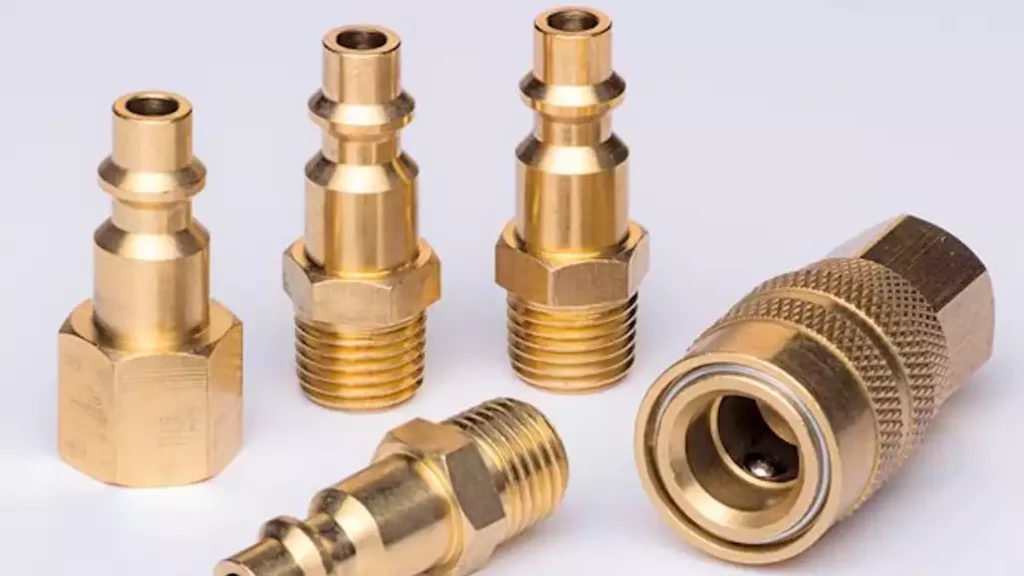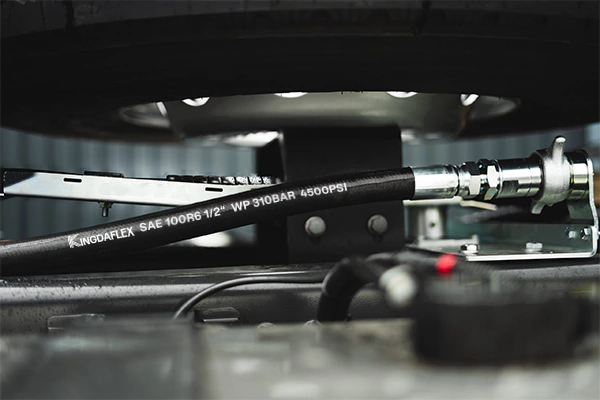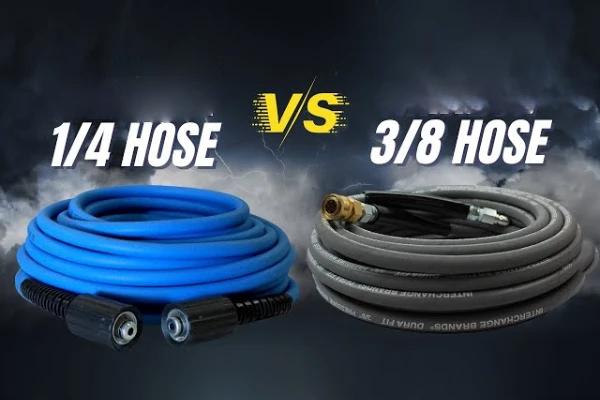Hydraulic hose quick connect is a type of connection mechanism used in hydraulic systems that allow for fast and easy attachment and detachment of hydraulic hoses.
In this blog, we happily share with you some benefits of hydraulic hose quick connect. Here we go~
What Are Hydraulic Hose Quick Connects?
Hydraulic hose quick connects are a type of connection mechanism that allows for fast and easy attachment and detachment of hydraulic hoses in a hydraulic system. They typically consist of a male and female end that can be connected and disconnected without the need for tools or extensive procedures.
Hydraulic hose quick connects are designed to save time and effort in situations where hoses need to be frequently changed or disconnected for maintenance, repair, or replacement. They also help reduce the risk of fluid leaks and contamination that can occur with traditional threaded connections.
Hydraulic hose quick connect come in a variety of sizes and configurations to fit different hydraulic hose types and system requirements. They are commonly made of durable materials such as stainless steel, brass, or plastic, and can be single or double shut-off, straight-through, or threaded and push-to-connect.
Hydraulic hose quick connects are an important component of many hydraulic systems and can provide a number of benefits in terms of ease of use, efficiency, and safety.
What Are Hydraulic Hose Quick Connects Made of?
Hydraulic hose quick connects can be made from a variety of materials, depending on the application and the specific requirements of the hydraulic system. Some of the most common materials used for hydraulic hose quick connects include:
They are typically made of durable materials such as stainless steel, brass, or plastic, and come in a variety of sizes and configurations to fit different hydraulic hose types and system requirements.
- Stainless steel: This is a popular material for hydraulic hose quick connects because of its excellent resistance to corrosion, high pressure, and high temperatures.
- Brass: Brass is another common material used for hydraulic hose quick connects because of its resistance to corrosion and its ability to withstand high pressure.
- Aluminum: Aluminum is often used for lightweight hydraulic systems because it is lightweight, corrosion-resistant, and has good heat transfer properties.
- Plastics: Some hydraulic hose quick connects are made from plastics such as nylon or acetal. These materials are lightweight, corrosion-resistant, and affordable, making them a popular choice for low-pressure hydraulic systems.
In addition to the materials used for the body of the hydraulic hose quick connect, the seals and o-rings inside the quick connect can be made from materials such as nitrile, Viton, or EPDM. These materials are chosen for their chemical resistance and their ability to withstand high temperatures and pressures.
Types of Hydraulic Hose Quick Connects

Here are some widely used hydraulic hose quick connect types for your conference:
- Single shut-off quick connects: This type of hydraulic hose quick connect has a valve on one end that seals the hydraulic fluid, while the other end is open to allow the fluid to flow. Single shut-off quick connects are typically used in applications where one half of the connection remains pressurized.
- Double shut-off quick connects: This type of hydraulic hose quick connect has a valve on both ends of the connection, which allows for both halves of the connection to be sealed. Double shut-off quick connects are typically used in applications where both halves of the connection need to be disconnected and reconnected frequently.
- Straight-through quick connects: This type of hydraulic hose quick connect has a straight-through design that allows the hydraulic fluid to flow through the connection without any restrictions. Straight-through quick connects are typically used in applications where a high flow rate is required.
- Threaded and push-to-connect quick connects: Threaded quick connects have threads that screw onto the hydraulic hose, while push-to-connect quick connects have a collar that slides over the hydraulic hose and locks it into place. Threaded and push-to-connect quick connects are typically used in applications where a secure and leak-proof connection is required.
Additionally, they can help reduce the risk of fluid leaks and contamination that can occur with traditional threaded connections.
Benefits of Hydraulic Hose Quick Connects
Hydraulic hose quick connects are designed to make it faster and easier to connect and disconnect hoses without the need for special tools or lengthy procedures. They can save time and effort in situations where hoses need to be frequently changed or disconnected for maintenance, repair, or replacement.
- Ease of use and convenience: Hydraulic hose quick connects are designed for fast and easy connection and disconnection, without the need for tools or specialized knowledge. This makes them a convenient solution for applications where hoses need to be frequently changed or disconnected for maintenance, repair, or replacement.
- Durability and resistance to wear and tear: Hydraulic hose quick connects are typically made from high-quality materials, such as stainless steel, brass, or plastic, that are designed to withstand the harsh conditions of hydraulic systems. This makes them more resistant to wear and tear, and less likely to leak or fail over time.
- Time and cost savings: Hydraulic hose quick connects can save time and money by reducing the amount of time and labor required to change or replace hydraulic hoses. This can result in increased productivity and reduced downtime for equipment and machinery.
- Enhanced safety and efficiency: Hydraulic hose quick connects can help improve the safety and efficiency of hydraulic systems by reducing the risk of leaks, spills, and contamination. They can also help to minimize the amount of hydraulic fluid that needs to be drained and refilled during maintenance or repair work, which can reduce the risk of exposure to hazardous fluids and improve the overall efficiency of the system.
Overall, the features and benefits of hydraulic hose quick connects make them a valuable component of many hydraulic systems, and an important consideration for anyone involved in the design, installation, or maintenance of hydraulic equipment.
Installation and Maintenance of Hydraulic Hose Quick Connects

Hydraulic hose quick connects are essential components for hydraulic systems, as they allow for quick and easy connection and disconnection of hydraulic hoses. Proper installation and maintenance of hydraulic hose quick connects are critical to ensure system reliability, safety, and longevity. Here are some guidelines for the installation and maintenance of hydraulic hose quick connects:
Hydraulic Hose Quick Connect Installation:
- Ensure that the quick connects are the correct size and type for the hydraulic hoses they will be connected to. Refer to the manufacturer’s specifications and recommendations.
- Clean the hose ends and the quick connect components thoroughly to remove any dirt, debris, or contaminants that could damage the seals or prevent a secure connection.
- Align the hose end and the quick connect components properly and ensure that they are fully engaged before applying pressure to the system.
- Tighten the fittings according to the manufacturer’s recommended torque specifications. Over-tightening can damage the seals and under-tightening can cause leaks.
Hydraulic Hose Quick Connect Maintenance:
- Regularly inspect the quick connects for signs of wear, damage, or leaks. Replace any damaged or worn components immediately to prevent system failure and ensure system safety.
- Keep the quick connects clean and free of dirt and debris. Use a clean rag to wipe the connectors and ensure that no foreign material enters the system.
- Use only recommended fluids and materials when servicing the hydraulic system. Different fluids or materials can react with the seals and cause damage, leading to system failure.
- Follow the manufacturer’s recommended service intervals for replacing seals, O-rings, and other components to ensure system reliability and longevity.
In summary, proper installation and maintenance of hydraulic hose quick connects are critical to ensuring the safety, reliability, and longevity of hydraulic systems. Following the manufacturer’s specifications and recommendations, regularly inspecting and servicing the components, and using recommended fluids and materials are key practices to maintain a high-performance hydraulic system.
Final Thoughts
Hydraulic hose quick connects are an important component of hydraulic systems, offering a range of benefits and features that make them a popular choice for many applications. They are designed for fast and easy connection and disconnection, without the need for tools or specialized knowledge, making them a convenient solution for applications where hoses need to be frequently changed or disconnected for maintenance, repair, or replacement.
They are also durable and resistant to wear and tear, reducing the risk of leaks or failure over time, and can help to improve the safety and efficiency of hydraulic systems by reducing the risk of leaks, spills, and contamination. With a range of types and materials to choose from, hydraulic hose quick connects offer a flexible and reliable solution for many hydraulic applications.
Overall, they are an important consideration for anyone involved in the design, installation, or maintenance of hydraulic equipment.




